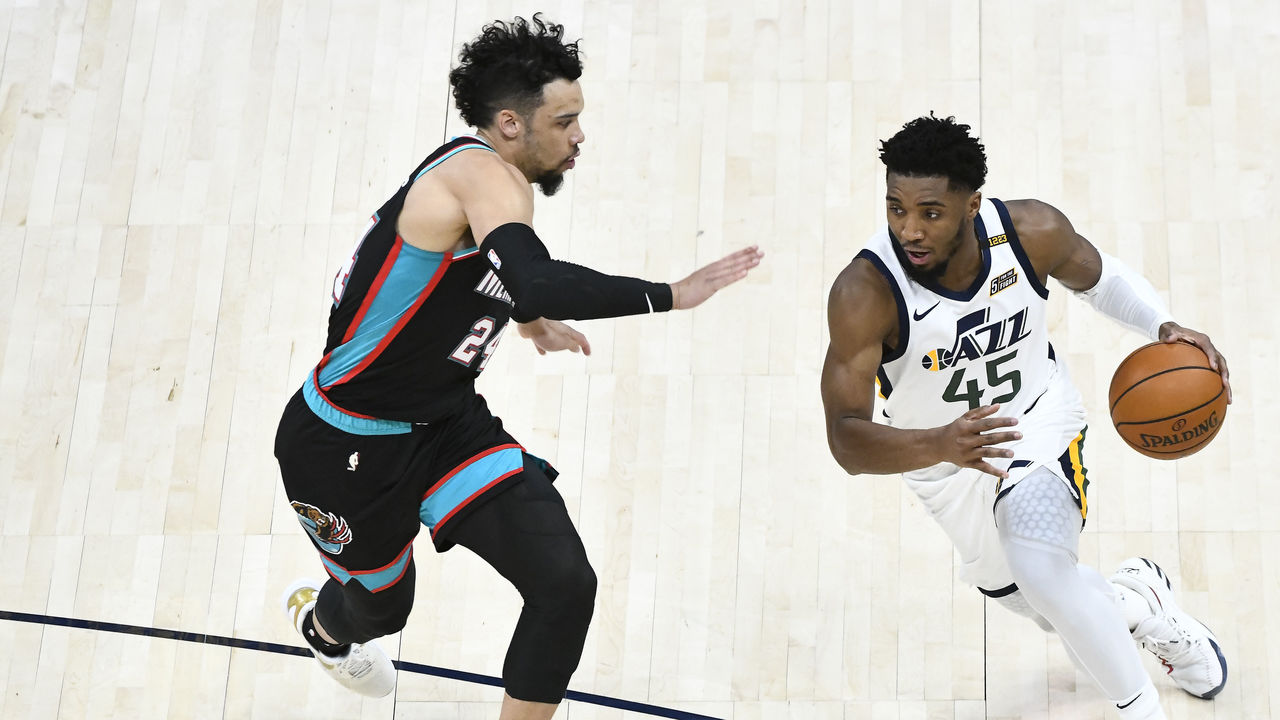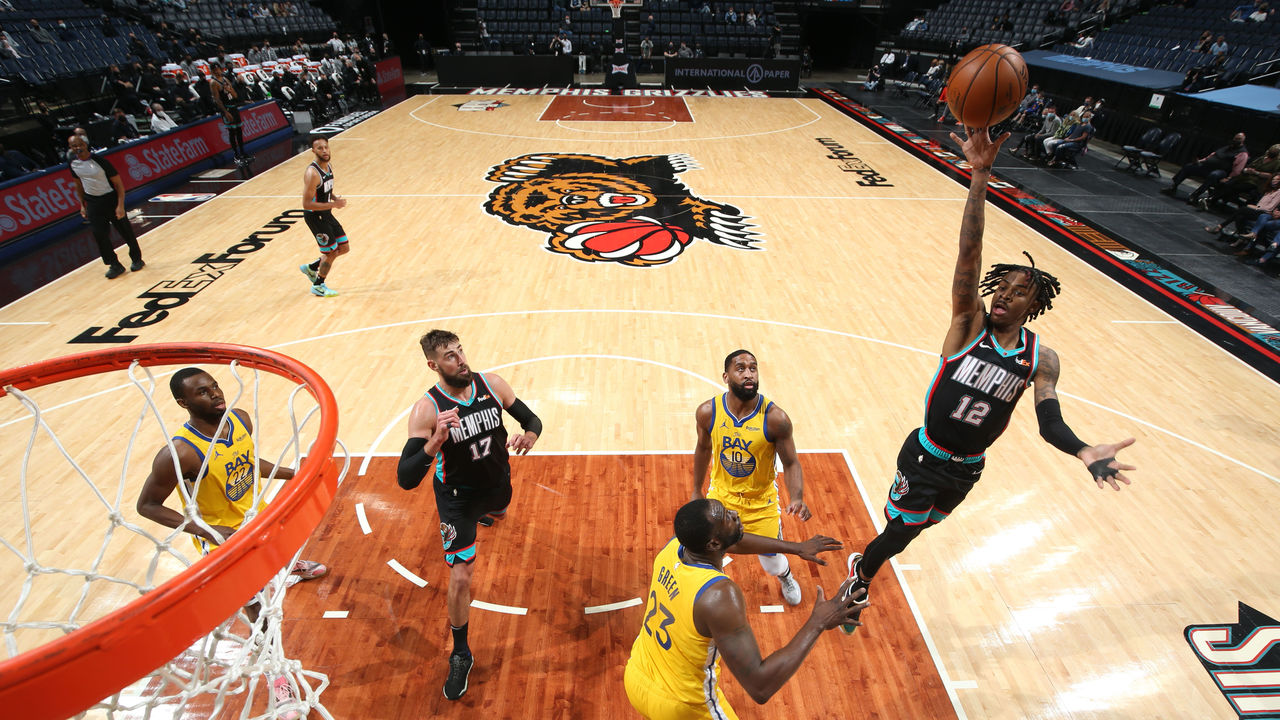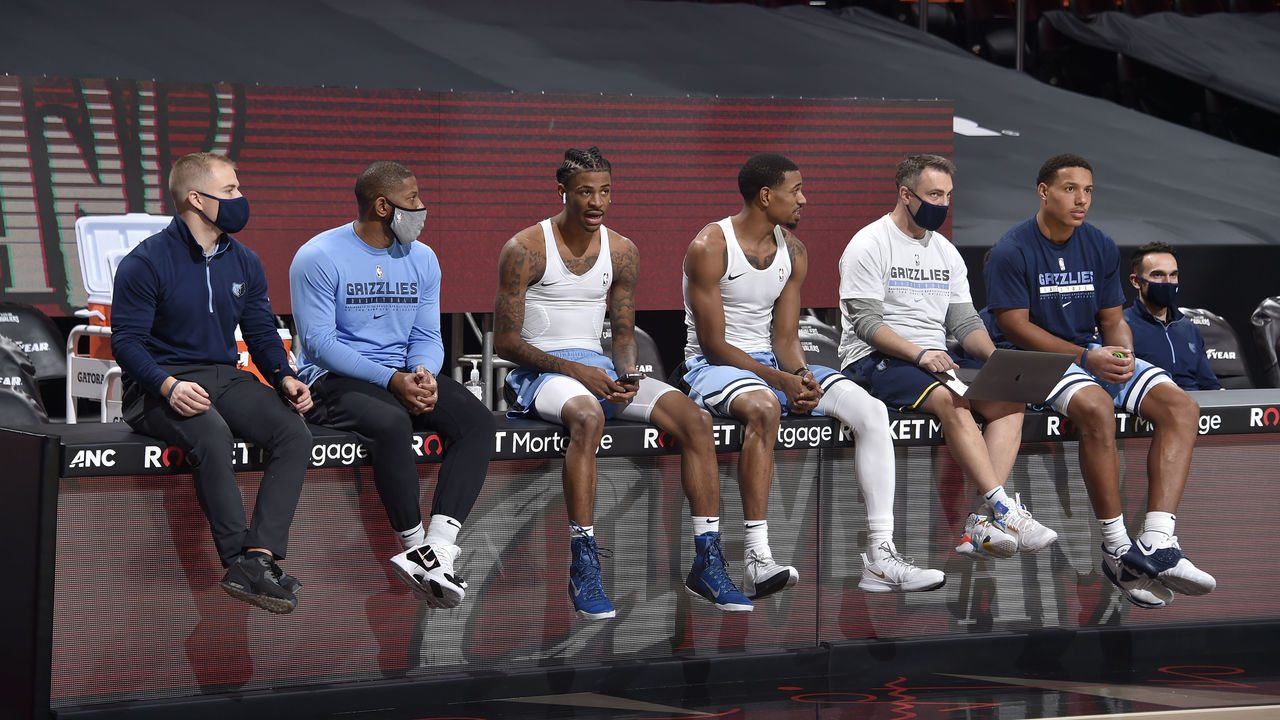What does the next step look like for the Grizzlies?
The Memphis Grizzlies are at an interesting stage of their team-building project.
They're still very much a team on the rise, and haven't yet had to confront the burden of external expectations. Their young core remains ahead of schedule, with its best days almost surely to come. After turning heads last year en route to a berth in the inaugural play-in tournament, Memphis is currently sitting at 22-22, entrenched in a West play-in spot once again despite playing without prodigious big man Jaren Jackson Jr. all season.
But even if it's too early in their development cycle to call any trend legitimately concerning, it's notable that the contours of the team's foundation look basically the same as they did last season. Some of the Grizzlies' strengths have become more pronounced, but so have their weaknesses. And in both cases, the onus rests with their unique crop of perimeter players. More than anything, it's that group that will ultimately decide what the next step for this team looks like.
The outer wall
The great triumph of the Grizzlies' season so far is their sixth-ranked defense. And while most great defenses are built from the inside out, theirs is strongest on the exterior.
They're by no means porous inside, just a tad flimsier there. Jonas Valanciunas is a strong paint protector and monstrous rebounder, but he can only play one scheme. Brandon Clarke is a defensive playmaker, but he still leaves his feet too readily and gets turned around when forced to defend multiple actions. Xavier Tillman is surprisingly polished defensively for a rookie, and he's better than Clarke at executing the hedge-and-recover scheme Memphis favors when Valanciunas sits, but his lack of height (6-foot-8) and vertical athleticism limits his impact as a deterrent at the rim.
The Grizzlies can lock teams down regardless because their perimeter defense is among the very best in the NBA. With a cadre of certified ball hawks - Dillon Brooks, De'Anthony Melton, Tyus Jones, Kyle Anderson, Justise Winslow - they force turnovers at the league's second-highest rate, and hold opponents to just 0.87 points per possession in isolation.

It starts with Brooks, a hellhound with a combination of strength and quickness that allows him to shape-shift across the positional spectrum. One night he'll be fronting Giannis Antetokounmpo in the post, the next he'll be chasing Bradley Beal or Jamal Murray through mazes of screens. He excels at ball denial and screen circumvention, executes textbook closeouts, and invades ball-handlers' personal space with relentless physicality.
That physicality results in copious fouls, and his overzealous efforts to deny handoffs leave him susceptible to back cuts. But those are tolerable concessions for the nightly headaches he causes opposing top scorers (aside from Donovan Mitchell, apparently). Just look at this dude:
Melton's length and reflexes allow him to be as disruptive as Brooks while being about half as aggressive. You can see how difficult it is to find openings when the two are patrolling the perimeter together:
The two don't share the floor often, but when they do, the Grizzlies hold opponents to a paltry 98.4 points per 100 possessions.
Anderson is a strong switch defender who can handle himself on-ball, but he really thrives as a weak-side gap-filler. He's always pulled in early, always sinks at the right time to help the helper, and rarely blows a rotation. Jones is a world-class pest at the point of attack, with phenomenal hands. Winslow has the size and balance to do basically anything asked of him.
Despite having arms that are thicker than they are long, rookie wing Desmond Bane has shown flashes of terrific team defense. So too has third-year guard Grayson Allen, who makes up for his own physical limitations with smart positioning and alert rotations:
Ja Morant is the one weak link. He gets wiped out on screens, gets bulldozed on switches, and gets caught ball-watching away from the play. But he's been competing harder at that end of the floor in recent games, and should eventually be able to settle in as an average defender. Even with his deficiencies, Memphis' current starting lineup has a defensive rating of 103.4 across 225 minutes, better than the Lakers' overall league-best mark of 105.8.
The Grizzlies allow a lot of above-the-break threes, but that's less about individual defensive failings than it is about their scheme, which prioritizes aggressive nail help, in part to protect against their vulnerabilities inside. They can be a bit too rigid with those help principles at times. On the play below, for example, Bane overreacted to a totally nonthreatening Aleksej Pokusevski drive, and in doing so bailed him out by opening up a simple passing read:
On the whole, though, the scheme works to limit penetration and provide necessary cover for the big men in the middle. Sometimes the best interior defense is good perimeter defense.
If Clarke, Tillman, and eventually Jackson (slated to return from a knee injury in late April) continue to progress, this should be an airtight unit for a long time.
Floating away
The downsides all come at the offensive end, where the Grizzlies' guards and wings are plagued by collective inefficiency. Their struggles are defined by a distinct lack of 3-point shooting, rim pressure, and self-creation.
Memphis ranks 28th in 3-point attempt rate and 26th in 3-point percentage. Now that Gorgui Dieng has been bought out, the only above-average long-range shooters on the roster are Bane, Melton, and Allen. None of those guys is playing more than 24 minutes a night, and none of them is a serious threat to pull a jumper off the dribble. In fact, outside of Morant and to a lesser extent Anderson, no one on the roster is much of a threat to create any kind of profitable shot for himself off the bounce. Morant and Brooks are the Grizzlies' highest-volume pull-up 3-point shooters, and they're shooting 20.5% and 26.5%, respectively.
The Grizzlies lead the league in points in the paint, which gives the impression they're a dominant interior scoring team. But that doesn't quite tell the whole story. They play effectively through Valanciunas in the post, and Morant's passes generate plenty of layups and dunks for his big men, but the team's drives stop short of the rim more often than not. A huge proportion of their paint shots come from between the restricted area and the free-throw line, the zone known colloquially as "floater range."
According to Synergy tracking data, Memphis has six guys (Jones, Morant, Tillman, Allen, Clarke, and Anderson) who rank in the top 30 in floater frequency, and three more (Bane, Melton, and Winslow) in the top 50. As a team, the Grizzlies shoot 14.5 floaters per game, which leads the league by a comical margin. The gulf between them and the second-ranked Knicks (at 9.9 per game) is equivalent to the gap between the Knicks and the 16th-ranked Thunder. All told, 19% of the Grizzlies' half-court possessions result in floaters, more than any team in the 17-year Synergy database. Only last year's Memphis team even comes close.

To the Grizzlies' credit, they're very good at hitting their signature shot. They produce 0.943 points per floater, which is slightly better than their average mark on all half-court possessions. But while there's a lot of value in being able to consistently knock down a shot that modern defenses are all too willing to concede, it's difficult to be an above-average offense while subsisting on the volume of floaters Memphis is currently lofting, because of the types of shots that consequently fall by the wayside.
To wit: on top of their low 3-point rate, the Grizzlies rank 26th in free-throw attempt rate and 19th in at-rim attempt rate, which helps explain why they own the league's fourth-worst half-court offense. There's a natural correlation between the team-wide proclivity for push shots and the lack of frequency with which they create contact and get to the free-throw line. Their overall offensive rating is salvaged by how often and how effectively they get out in transition - a direct result of all the turnovers they force - but they wind up on the wrong end of the math equation many nights.
Of Memphis' regular rotation players, only Morant and Valanciunas rank above average at their positions in at-rim attempt rate, according to Cleaning the Glass. By comparison, every single player on the roster is above average at their position in short mid-range frequency, and eight of them rank in the 90th percentile or better. Morant is the team's only perimeter player who gets to the rim with any regularity, and he still averages nearly as many shots from floater range (5.1) as he does from inside the restricted area (six).
It's helpful to be able to take what the defense gives you, but defenses invite in-between shots from every team and no one else is accepting those invitations nearly as often as Memphis is. There needs to be more balance.
Of course, it's not as simple as saying the Grizzlies should turn more of those floaters into layups or threes, especially when the roster is so light on high-end finishers and shooters, and when their opponents freely pack the paint. What good would it do them to repeatedly bang their heads against the wall trying to score through a sea of bodies at the basket, or to force-feed their poor shooters from beyond the arc? This is more a personnel issue than a schematic one.
Brooks, Winslow, Jones, and Bane all struggle mightily to score among the trees. Anderson's length makes him a solid finisher, but his lack of burst means he doesn't get all the way to the hoop - or to the free-throw line - very often. Winslow can bully the odd smaller defender on a drive, but his shooting from every zone has been a disaster. Jones is simply limited by his small stature, and an uncontested floater is almost always a better option for him than a contested layup. He's one of the only players in the league who shoots better from floater range than he does right at the rim.
To be fair, the Grizzlies have been without their best and highest-volume 3-point shooter all season. Jackson is nominally a big, but offensively he functions more like a 7-foot shooting guard. And when he returns, he should both goose the Grizzlies' 3-point attempt rate and open up the paint to help their guards get all the way to the hoop.
When Jackson was on the floor last season, the Grizzlies saw a 2.1% increase in shot attempts at the rim, a 4.3% increase in 3-point shots, and a 6.4% decrease in mid-range shots, per Cleaning the Glass. (Dieng's floor-spacing presence this season didn't have the same impact on rim frequency, but it did correlate with a 10.1% increase in 3-point attempt rate.)
But even then, the Grizzlies' shot spectrum looked a bit retrograde. Jackson's return isn't going to magically solve all their problems, in the near or long term. They're still going to need more shooting in the backcourt and on the wing. And they'll still need more downhill attackers who can slice through the defense rather than stopping short to loft floaters because they aren't explosive enough to power through contact at the rim.
The next step

Can the Grizzlies address their offensive needs without compromising the perimeter defense that's buoyed their earlier-than-expected success? And if not, how much of their defensive identity can they afford to sacrifice? Alternatively, should they just stay patient and hope their issues can be remedied through the draft and internal improvement? These are the questions the front office will have to answer as the team transitions to the next phase of its development cycle.
As things stand, the Grizzlies are overly dependent on Morant's off-the-bounce creation and rim pressure, and have to live with what he gives back at the defensive end. This season, they've scored 6.9 more points per 100 possessions - and allowed 7.4 more points per 100 - with him on floor than they have with him on the bench.
For all his speed and acrobatic craft, Morant is also easier to scheme for than most lead guards because he poses almost no threat outside of 15 feet. Defenses duck under screens, play him with a sizable gap, and completely ignore him off-ball. He still has obvious superstar potential, and his surging free-throw rate is a crucial development, but for now things look slightly less rosy than they did when he flirted with league-average 3-point shooting as a rookie.
Brooks is also, in his own way, a microcosm of the Grizzlies' struggle to find balance. He's arguably the linchpin of the team's defense, but his shaky outside shooting, iffy finishing, questionable shot selection, and lack of interest in playmaking for others contribute to Memphis' offensive woes. Of course, somebody needs to take the shots, and if nothing else Brooks is unafraid to do so. But there's a limit to how good a team can be offensively when a guy with a 45.8% effective field-goal percentage is taking more than 15 shots a game.
The Grizzlies opted to not make any moves at this year's deadline, but their depth could make them ripe for a consolidation trade in the offseason. If they choose not to exercise their team option on Winslow, they'll also have about $25 million in cap space to play with. Would that be enough incentive to cut bait on a once-promising player with a sky-high defensive ceiling?
Splashing around in the free-agency waters is always a dicey proposition in a market like Memphis - and hasn't worked out particularly well for the Grizzlies in the past - but they should consider throwing a decent-sized bag at Norman Powell because he'd be a near-perfect fit.
There are lots of potential avenues for internal development. Melton's already made a huge leap as a creator and shooter this season (though he was starting basically from scratch so he still has a ways to go). Allen and Bane could round out their offensive games without taking anything off the table defensively. While neither of them currently profiles as a downhill attacker, their shooting ability will give them plenty of hard closeouts to attack. Adding a viable pull-up three would unlock all sorts of things for Morant and the team.
There's no reason to think the Grizzlies can't or won't ultimately make good on the promise they've shown in the early portion of their accelerated rebuild. But it's one thing to become a competent, .500-ish team before anybody anticipated, and quite another to transition from precocious upstart to sustainable winner.
From that standpoint, this season has demonstrated two things: the Grizzlies are on the right track, and they have some specific weaknesses they badly need to address if they're to make the leap in the future.
HEADLINES
- Eagles fend off Cowboys after weather delay to kick off season
- Cowboys-Eagles opener resumes after 65-minute lightning delay
- Rays beat Guardians to extend win streak to 7 games
- 49ers' McCaffrey added to injury report with calf issue ahead of opener
- Skenes pitches 6 scoreless innings as Pirates beat slumping Dodgers